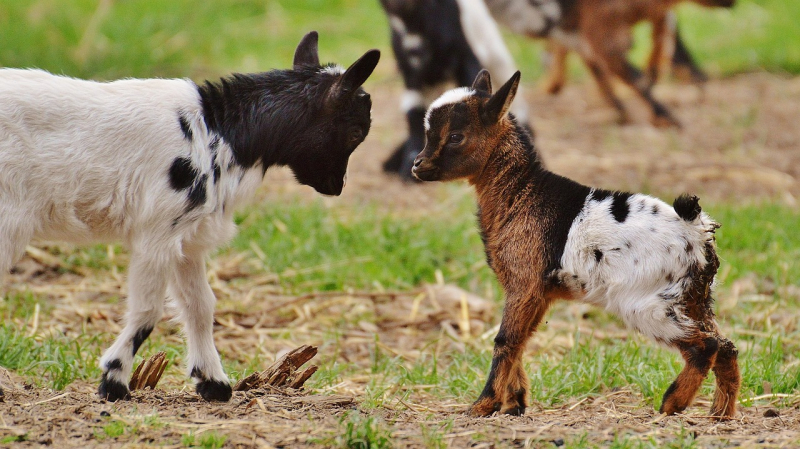Playful Paws and Hooves: Do Herbivore Young Play Like Carnivores?
» Deer stories » Other Animals » Playful Paws and Hooves: Do Herbivore Young Play Like Carnivores?Nature's playground is filled with diverse and fascinating creatures, each exhibiting unique behaviors that captivate our attention. While we often associate playful antics with carnivores, the question arises: do herbivore young engage in play similar to their meat-eating counterparts? The answer may surprise you, as the world of herbivores reveals a playful side that challenges stereotypes.

image credit: Alexa from Pixabay
Playful Prances and Leaps
Contrary to popular belief, herbivore young are not immune to the charms of play. Take, for example, the African elephant calves. These majestic herbivores are known for their playful wrestling matches, enthusiastic trunk-tugging games, and exuberant splashing in water holes. Their large ears flap joyfully as they engage in friendly sparring, mirroring the rough-and-tumble play of carnivore cubs.
Similarly, young giraffes engage in spirited necking contests, where they playfully butt heads with their long necks in a dance that mirrors the mock battles of big cat cubs. These herbivores may not have sharp teeth or claws, but their playful interactions are just as energetic and entertaining.
Bounding Bambi and the Deer Playground
In the forested realms, herbivores like deer showcase their playful side in enchanting ways. White-tailed deer fawns, often likened to the beloved Disney character Bambi, engage in lively games of tag and chase. Their agile leaps and bounds through the underbrush mirror the playful antics of carnivore young, demonstrating that a love for frolic is not exclusive to meat-eaters.
Goats: The Undisputed Kings of Caprine Capers
One cannot delve into the world of playful herbivores without mentioning goats. These domesticated herbivores are renowned for their mischievous antics and acrobatic displays. Goat kids engage in spirited games of "king of the hill," climbing and jumping with unparalleled agility. Their exuberance showcases that playful behavior is not limited by dietary preferences.
The Social Play of Grazing Giants
Herbivores often live in social groups, and their playful interactions are integral to developing social bonds. Wildebeest calves, for instance, engage in joyful romps across the savannah, reinforcing the bonds within their migratory herds. The playful behavior of these herbivores mirrors the importance of social play in carnivore societies, where young predators hone their skills through playful interactions.
Herbivores' Play in Captivity
Herbivore mammals that live in captivity, on farms, in zoos, or in sanctuaries, can be spotted playing with unusual objects, which they wouldn't normally encounter in the wild:
Our very own deer do use odd things they come across for play. Kicking, tossing, chewing on them just beause they can:
Final Thoughts
In the grand tapestry of the animal kingdom, herbivores and carnivores alike weave threads of playfulness into the fabric of their lives. From the majestic elephants of Africa to the nimble deer of the woodlands, herbivore young engage in games that echo the spirited play of their carnivorous counterparts. While the methods and motives may differ, the joy, camaraderie, and sheer exuberance displayed by herbivore young challenge preconceived notions about play in the animal kingdom. The next time you witness a group of frolicking herbivores, remember that the playful spirit knows no dietary boundaries.
Published 11 November 2023
More «Other Animals» stories
Spit Happens! (What Animals Spit and Why)
If you thought spitting was just a human thing, think again! Animals are joining the slobber spectacle, and trust me, they've got quite the repertoire of spit-tastic moves. From llamas to camels, the animal kingdom is spewing surprise after surprise. So, buckle up and get ready for a wild ride through the fantastic and funny world of animal spit!
read more...
What Animals Can Eat Oats
Oats stand out among cereals. Around the world, they're used in livestock feed and pet food. List of animals that can consume oats and benefit from eating oatmeal.
read more...
Which Deer Species Can Interbreed and Produce Hybrids
Interbreeding between different deer species is often restricted due to factors like genetic differences, geographical isolation, mating behaviors, and breeding seasons that don’t align. While some hybrids might be fertile, others could be sterile or have reduced fertility, limiting the potential for ongoing interbreeding between species.
read more...
 '
'


